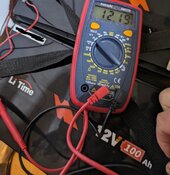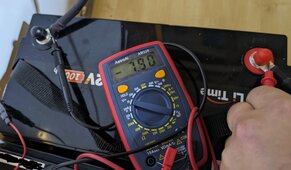Scoob-SanDiego
New Member
I have a new MPP LV2424 and a pair of LiTime 12V 100AH batteries that I bought in their "Like New" section (for $203).
Setting up my MPP with 4 solar panels and my two batteries in series for the prescribed 24V battery bank.
All was working OK but my 2 batteries were barely enough to last through the night before the sun would come back.
During the initial setup, I had the MPP AC input connected to the wall outlet using a GFCI extension cord.
One morning I came in and everything was OFF. I figured I had not configured the MPP correctly and the batteries ran low (then the MPP shutoff).
When I measured my battery voltages, I noticed that one battery was at 12.19V and the other was alarmingly at only 7.9V !!!
I promptly disconnected and recharged the batteries using a separate charger.
I reviewed the MPP setup and all seemed in order. So I reconnected everything and after a couple of day the same thing happened again
with the same distressing LOW LOW voltage on that one battery.
Further investigation revealed that the GFCI breaker had popped and when the battery would reach 23V in the middle of the night, the MPP was unable to feed itself (50W) and the load (45W at night) using the line-in and instead kept on sucking on the battery.
The MPP is set (default value) with a Low DC cut-off voltage of 21.0V (the manual doesn't elaborate on what it does when that threshold is reached, cut the load or shutoff the entire MPP (which it should!)
I'm not too sure what exactly happened to deplete that battery that much.
A few things come to mind:
1) It seems WEIRD that one battery should be depleted so much deeper than the other one
2) 12.19V + 7.9V = 20.09V... Presumably the MPP "low DC cut-off voltage" would have been triggered... but if the MPP stays on, it would keep sucking 50W!
3) I would expect the BMS on the LiTime battery to shutoff somewhere between 10 and 11V. Right????
QUESTIONS:
A) Does anyone have a better understanding of what took place?
B) Does anyone know exactly what the behavior of the MPP "low DC cut-off voltage" is?
C) Am I right in believing that I have a deffective BMS on that second LiTime battery?
Thanks in advance for your input!!!
- Christian
Setting up my MPP with 4 solar panels and my two batteries in series for the prescribed 24V battery bank.
All was working OK but my 2 batteries were barely enough to last through the night before the sun would come back.
During the initial setup, I had the MPP AC input connected to the wall outlet using a GFCI extension cord.
One morning I came in and everything was OFF. I figured I had not configured the MPP correctly and the batteries ran low (then the MPP shutoff).
When I measured my battery voltages, I noticed that one battery was at 12.19V and the other was alarmingly at only 7.9V !!!
I promptly disconnected and recharged the batteries using a separate charger.
I reviewed the MPP setup and all seemed in order. So I reconnected everything and after a couple of day the same thing happened again
with the same distressing LOW LOW voltage on that one battery.
Further investigation revealed that the GFCI breaker had popped and when the battery would reach 23V in the middle of the night, the MPP was unable to feed itself (50W) and the load (45W at night) using the line-in and instead kept on sucking on the battery.
The MPP is set (default value) with a Low DC cut-off voltage of 21.0V (the manual doesn't elaborate on what it does when that threshold is reached, cut the load or shutoff the entire MPP (which it should!)
I'm not too sure what exactly happened to deplete that battery that much.
A few things come to mind:
1) It seems WEIRD that one battery should be depleted so much deeper than the other one
2) 12.19V + 7.9V = 20.09V... Presumably the MPP "low DC cut-off voltage" would have been triggered... but if the MPP stays on, it would keep sucking 50W!
3) I would expect the BMS on the LiTime battery to shutoff somewhere between 10 and 11V. Right????
QUESTIONS:
A) Does anyone have a better understanding of what took place?
B) Does anyone know exactly what the behavior of the MPP "low DC cut-off voltage" is?
C) Am I right in believing that I have a deffective BMS on that second LiTime battery?
Thanks in advance for your input!!!
- Christian





